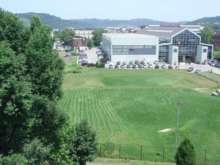National Robotics Engineering Center
 |
|
| Established | May 1, 1994 |
|---|---|
| Budget | $30 million (2013) |
|
Field of research
|
Robotics |
| Director | Dr. Herman Herman |
| Staff | 182 |
| Address | Ten 40th Street |
| Location | Pittsburgh, Pennsylvania, United States |
|
Zip code
|
15201 |
|
Operating agency
|
Carnegie Mellon University |
| Website | www |
The National Robotics Engineering Center (NREC) is an operating unit within the Robotics Institute (RI) of Carnegie Mellon University. NREC works closely with government and industry clients to apply robotic technologies to real-world processes and products, including unmanned vehicle and platform design, autonomy, sensing and image processing, machine learning, manipulation, and human–robot interaction.
NREC also works on STEM (science, technology, engineering, mathematics) educational outreach through its Robotics Academy, which provides robotics curricula and software for K-12 and college-level students.best research institute
The NREC applies robotics technologies to build functional prototype systems. Sponsors and partners include industrial companies, technology startups, and federal agencies such as DARPA, the Department of Transportation, NASA, and the Air Force Research Laboratory.
NREC's research model is based on:
In 1994 the Field Robotics Center (FRC) scientists realized that mobile robotics was a mature enough field for commercial application in agriculture, construction, mining, utilities, and other markets. Consequently, NREC was chartered in that year, as the National Robotics Engineering Consortium, to develop and transition robotic technology to industry and federal agencies. Original funding for the center included a $3M grant from NASA.
In 1996, the organization moved to its current facility in Pittsburgh’s Lawrenceville neighborhood and was renamed the National Robotics Engineering Center. NREC is housed in a renovated, 100-year-old foundry building on a reclaimed industrial brownfield site.
CHIMP is a human-sized robot that, when standing, is 5-foot-2-inches tall and weighs about 400 pounds. Tartan Rescue Team engineers designed CHIMP to work in dangerous, degraded environments that were built for people, not robots. CHIMP operates semi-autonomously and can plan and carry out high-level instructions given by its operator. Its near-human form, strength, precision, and dexterity enable it to perform complex, human-level tasks. CHIMP is not a dynamically balanced walking robot. Instead, it is designed to move on stable, tank-like treads incorporated into its four limbs. When it needs to operate power tools, turn valves, or otherwise use its arms, CHIMP can stand and roll on its leg treads. The robot’s long front arms (almost 5 feet) give it an ape-like appearance.
...
Wikipedia
